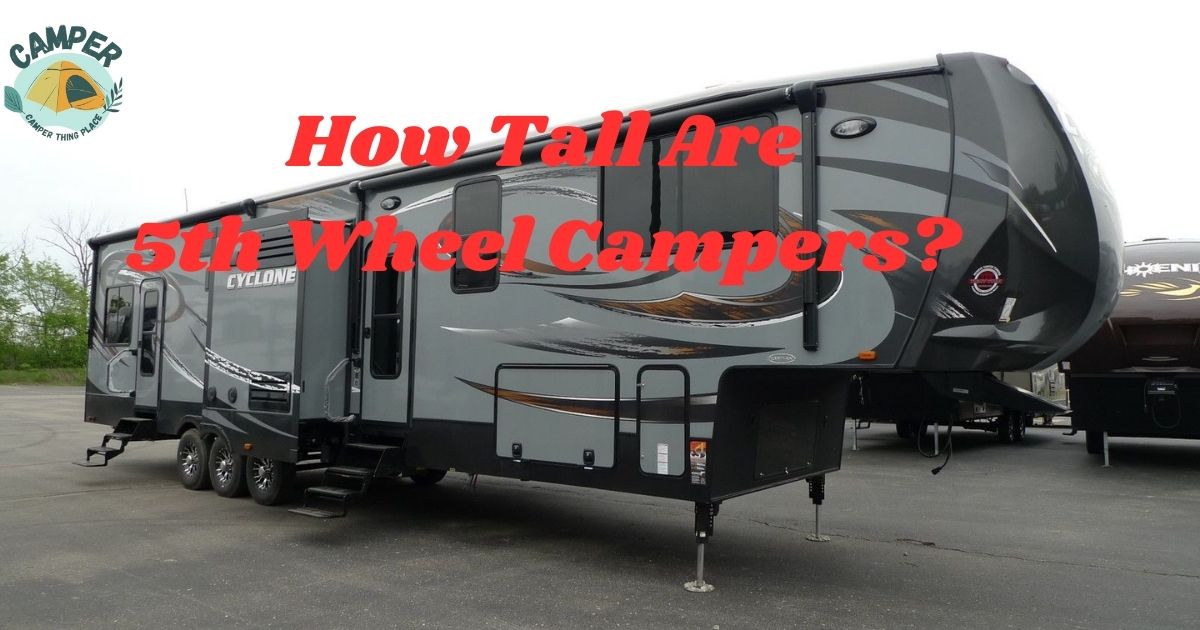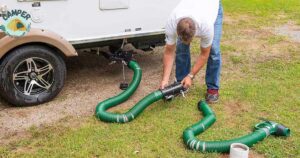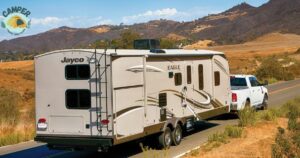5th Wheel Campers are spacious towable trailers designed for travel and camping. They attach to the bed of a pickup truck, providing a comfortable and versatile home away from home.
Embark on a journey with 5th Wheel Campers, where the open road becomes your playground and the destination is just the beginning. Some people raise a question about how tall is 5th-wheel camper. So here is complete detail about the 5th wheel camper. These towable marvels redefine travel, offering spacious interiors and the freedom to roam wherever your heart desires.
5th Wheel Campers vary in height, but on average, they range from 11 to 13 feet tall. This provides ample headroom and a comfortable living space. It’s essential to check the specific model’s height to ensure a smooth and worry-free travel experience.
What is the Average Height of a 5th Wheel Campers?
Typically, 5th wheel campers stand between 11 to 13 feet tall. This height ensures a spacious interior, allowing you to move comfortably and enjoy a cozy living space while on the road.
Keep in mind that the exact height can vary based on the model and manufacturer. Before embarking on your journey, always check the specifications of your specific 5th Wheel Campers, especially if you own the smallest drivable RV, to ensure it aligns with your travel preferences and any potential height restrictions along your route.
Many states impose a maximum height limit of 13.5 feet, making it illegal to travel with a camper exceeding this threshold.
5th wheel camper heights are categorized into classes known as Class A, Class B, and Class C.
Class A
Class A recreational vehicles (RVs) typically range in height from 12 to 13 feet and 6 inches. It’s important to note that they do not exceed the height limit of 13 feet 6 inches.
This specific height range allows for greater flexibility in travel, as Class A RVs can navigate various routes without clearance concerns.
Their design ensures that they can easily pass under bridges. Providing owners with the freedom to explore a wide range of locations without encountering height restrictions.
Class C
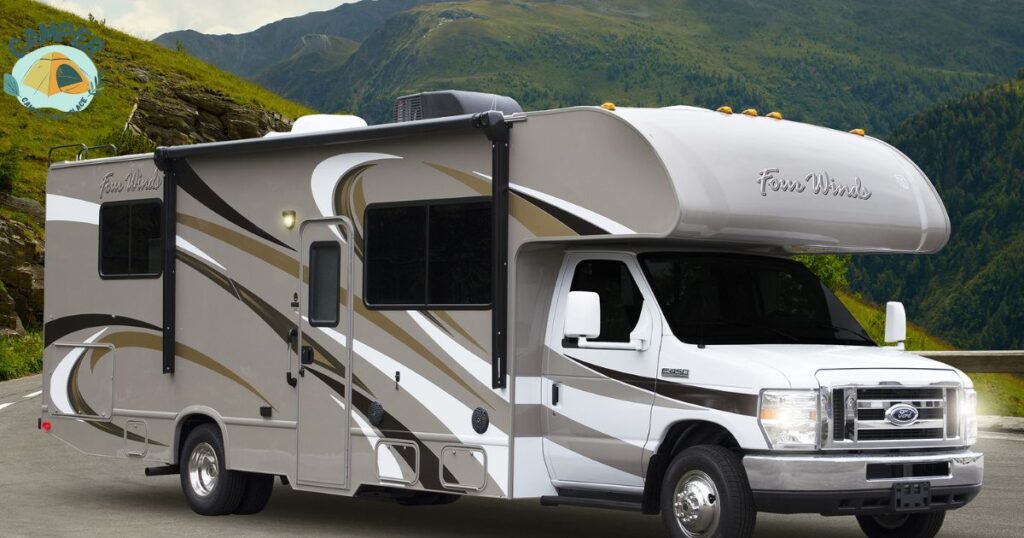
Class C campers are characterized by their comparatively shorter stature when compared to Class A campers.
Typically standing between 10 and 12 feet in height, these campers offer a more compact and maneuverable option for travelers.
The reduced height of Class C campers makes them suitable for various environments and parking situations.
Providing a versatile and convenient choice for those seeking a more manageable recreational vehicle experience.
Class B
These compact campers, ranging from 8 to 10 feet in length, are the smallest in size. Class B campers prove to be an ideal choice for travelers.
Seeking minimal problems and a hassle-free experience during their journeys. With their compact dimensions, these campers offer convenience and ease of maneuverability.
Making them well-suited for individuals prioritizing simplicity and efficiency in their travel accommodations.
How to Measure a 5th Wheel Camper’s Height?
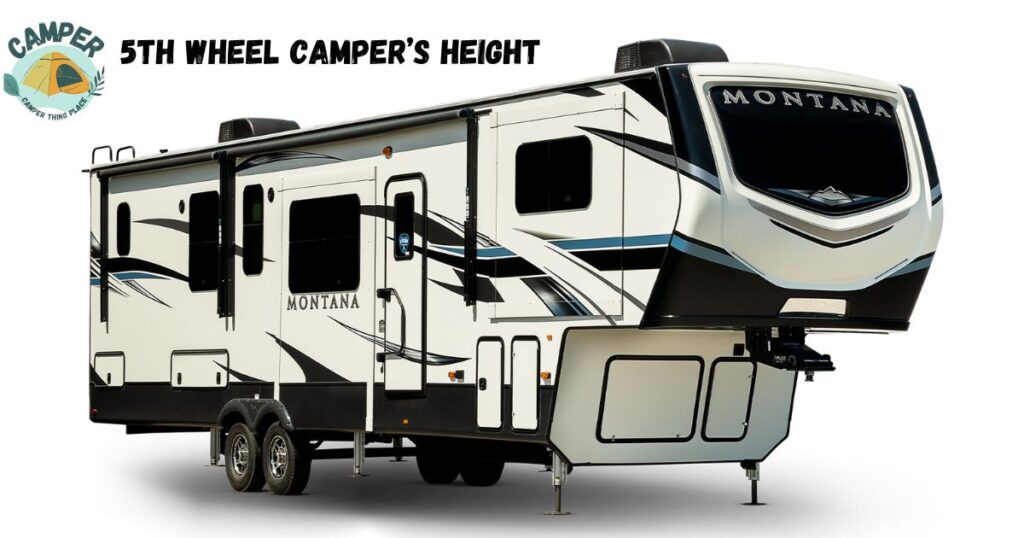
To accurately determine the height of your 5th Wheel Campers, it’s recommended to personally measure it.
Whether you’ve recently purchased it or already own one, taking your measurements is a prudent practice.
Measure the 5th wheel camper’s height both when it’s unhitched and hooked up, as attaching a hitch expands the overall size of the camper.
Measuring a 5th Wheel Camper’s height is a straightforward process to ensure a smooth and safe travel experience. Here’s a simple guide:
- Level Ground: Park the 5th Wheel campers on a flat and level surface, ensuring it’s not on an incline or decline.
- Unhitch the Trailer: Detach the 5th Wheel campers camperfrom the towing vehicle to allow for accurate measurements.
- Vertical Measurement: Position a measuring tape or extendable ruler vertically from the highest point on the camper, often the roof, to the ground. Ensure the tape is straight for an accurate measurement.
- Note the Measurement: Record the height measurement in feet and inches. This figure represents the overall height of your 5th Wheel camper.
- Check for Variations: Keep in mind that accessories like air conditioners or antennas may contribute to variations in height. Take note of any additional elements that could affect clearance.
By following these steps, you can confidently determine the height of your 5th Wheel Camper, allowing you to plan your routes and ensure a hassle-free travel adventure.
Why Should You Know Your 5th Wheel Campers Height?
Knowing your 5th wheel campers height is crucial for a smooth and stress-free travel experience. It helps you navigate safely through underpasses, bridges, and tunnels, avoiding potential collisions and damage.
Additionally, being aware of the height ensures you can plan your routes effectively. Choosing paths that accommodate your RV’s dimensions, and preventing unexpected obstacles that may arise during your journey.
Ultimately, understanding your 5th wheel camper’s height is a practical measure to enhance safety and enjoyment on the road.
Increase Weight
The weight of your 5th wheel camper is directly proportional to its height. Influencing the size of the truck needed to tow the camper.
Although it is feasible to move your 5th wheel without a truck, it is essential to have the appropriate equipment and rigging to effectively manage your specific situation.
This includes considering factors such as weight distribution, towing capacity, and safety measures to ensure a smooth and secure transportation experience for your 5th wheel camper.
Underpasses & Bridges
Navigating bridges and underpasses poses a considerable challenge for 5th wheel camper drivers. While the majority of road bridges surpass a height of 13 feet 6 inches, allowing for smooth passage, it’s essential to be cautious.
Some bridges, particularly in the northeast, were built before standard height requirements became prevalent. Consequently, these older structures may have a lower clearance.
Although encountering shorter bridges is less common in other regions, drivers must remain vigilant and aware of their surroundings, as such obstacles may still be present on the road.
Campsites
Simply reaching the campsite isn’t sufficient; one must also be vigilant about the awnings. Upon arrival, some travelers may find themselves uncertain about the proper course of action. Many campsites designate a specific entrance for larger, more costly 5th wheels campers.
Unfortunately, there are instances where individuals mistakenly choose the wrong entrance, leading to potential damage. When arriving at a campsite, it’s crucial to not only reach the destination but also be mindful of the awnings, which are overhead coverings often attached to vehicles or structures.
The challenge arises when travelers, upon reaching the campsite, are unsure of the correct procedures to follow. Campsites typically provide a separate entrance for larger and more expensive vehicles, such as 5th wheels campers, to ensure smoother navigation and parking.
However, complications arise when individuals inadvertently choose the wrong entrance, leading to the risk of damaging their vehicles or property.
Therefore, campers need to familiarize themselves with the campsite layout and adhere to designated entrances to avoid any potential mishaps.
Garages For 5th Wheel Campers
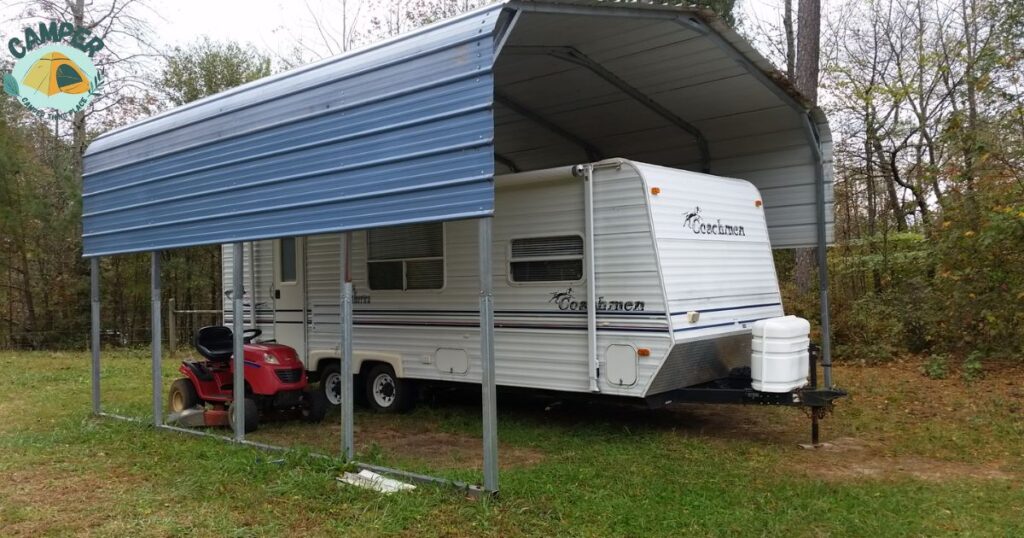
Typically, individuals don’t commonly store their RVs in garages, but understanding relevant details is advantageous. The majority of urban parking garages have limited height clearance, typically not exceeding 6 or 7 feet.
Consequently, it becomes impractical to park RVs inside these structures. Therefore, if you desire to store your RV in a garage, it’s essential to seek out a facility specifically designed to accommodate the larger dimensions of recreational vehicles.
This ensures that your RV can be securely parked indoors, protecting it from the elements and providing additional security.
Foliage
Navigating through areas with dense tree foliage poses a significant challenge for RV drivers, particularly when exploring the countryside where lush vegetation abounds. The absence of warning signboards adds to the difficulty of avoiding overhanging tree limbs.
Necessitating a proactive approach where drivers must remain vigilant and look out for potential obstructions. While interstate travel may present fewer challenges, the proximity to campsites intensifies the issue, with an increasing prevalence of tree limbs obstructing the path.
This obstruction is not just a sporadic inconvenience; at times, it extends for considerable distances, posing a continuous threat to the front and sides of the vehicle and potentially causing extensive damage.
As such, RV drivers need to exercise heightened caution in these areas to ensure a safe and smooth journey.
How to Avoid Mishaps Due to Your 5th Wheel Camper’s Height?
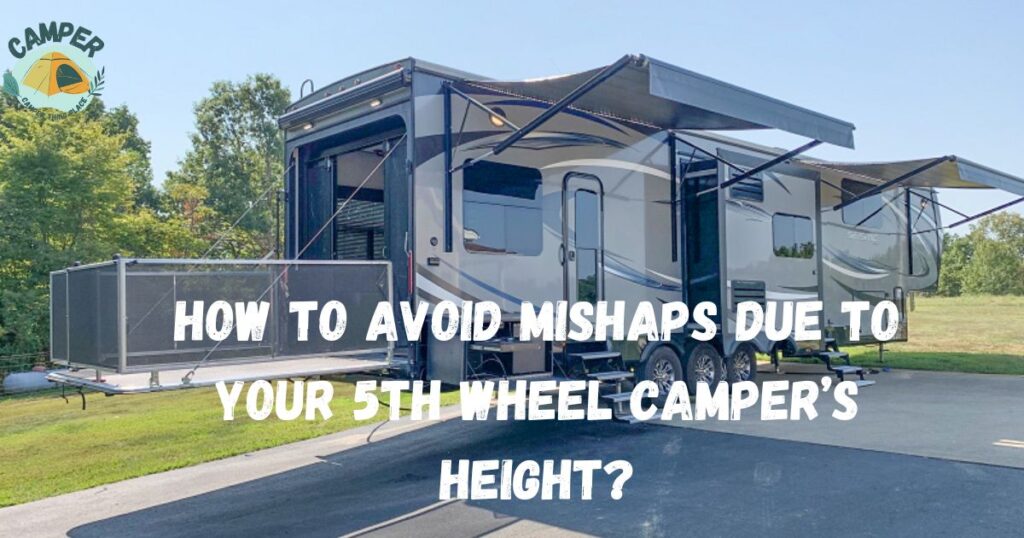
Preventing mishaps related to your camper’s height is essential for a trouble-free journey. Follow these steps to avoid potential issues:
Know Your 5th wheel Camper’s Height
Take precise measurements of your 5th wheel camper’s height, considering any additional features like antennas or air conditioners. This knowledge forms the foundation for safe navigation.
Plan Your Route
Utilize online resources or specialized RV navigation apps to plan your route. Look for routes with sufficient clearance and avoid areas with low bridges or tunnels that could pose a threat to your camper’s height.
Use a Proper GPS
Ensure you have a dependable GPS service when embarking on camper journeys. Among the various options, the most suitable choice is an RV GPS.
While many travelers opt for Waze, it may not be the best fit. Waze overlooks the height of your camper, potentially leading you down roads with challenging bridges and underpasses, posing a risk of damage to your trailer.
An RV GPS designed specifically for campers considers the size of your vehicle, providing route suggestions tailored to your camper’s dimensions. With a trustworthy RV GPS, your adventure can be enjoyed without encountering any obstacles along the way.
Include the AC Unit in the Measurements
Ensuring accurate measurement of your 5th wheel camper height is essential to avoid collisions and potential damage when navigating tunnels and bridges. It’s a common oversight for some individuals not to factor in the height of the air conditioning unit when determining the overall measurement.
Typically, the AC unit adds a foot to the total height, making it a critical component to include in your calculations. Failure to account for it may result in your unit contacting the tunnel or bridge, leading to expensive repairs.
Manage Your Speed under Bridges
It is crucial to exercise caution and reduce speed when driving beneath bridges to prevent potential accidents. Often, the vertical clearances beneath bridges can be limited, necessitating a slower pace to mitigate the impact of uneven road surfaces. This is particularly important for 5th wheel campers, as their suspension systems cause vertical movement in response to bumps. Moving too quickly under bridges can lead to the camper potentially colliding with the structure, highlighting the need for a measured and deliberate approach to ensure safety.
Height Limits in the US
In the United States, height limits for vehicles, including RVs, vary by state. Generally, the standard maximum height allowed on federal highways is 13 feet and 6 inches.
However, it’s crucial to be aware that individual states may have different regulations, and some areas may have lower clearance limits, such as bridges and tunnels.
Before embarking on your journey, check the specific height restrictions in each state you plan to visit to ensure compliance and avoid any potential height-related issues during your travels.
Below is an extensive compilation of states along with their respective regulations pertaining to the height of 5th wheel campers. This comprehensive list provides in-depth information about the specific height ragulations imposed by each state on 5th wheel camper trailers.
| State | Height Limit |
| Alabama | 13 feet 6 inches |
| Alaska | 15 feet |
| Arizona | 13 feet 6 inches |
| Arkansas | 13 feet 6 inches |
| California | 13 feet 6 inches |
| Colorado | 14 feet 6 inches |
| Connecticut | 13 feet 6 inches |
| Delaware | 13 feet 6 inches |
| District of Columbia | 13 feet 6 inches |
| Florida | 13 feet 6 inches |
| Georgia | 13 feet 6 inches |
| Hawaii | 14 feet |
| Idaho | 14 feet |
| Illinois | 13 feet 6 inches |
| Indiana | 13 feet 6 inches |
| Iowa | 13 feet 6 inches |
| Kansas | 14 feet |
| Kentucky | 13 feet 6 inches |
| Louisiana | 13 feet 6 inches |
| Maryland | 13 feet 6 inches |
| Maine | 13 feet 6 inches |
| Massachusetts | 13 feet 6 inches |
| Michigan | 13 feet 6 inches |
| Minnesota | 13 feet 6 inches |
| Mississippi | 13 feet 6 inches |
| Missouri | 13 feet 6 inches (14 feet on some roads) |
| Montana | 14 feet |
| Nebraska | 14 feet 6 inches |
| Nevada | 14 feet |
| New Hampshire | 13 feet 6 inches |
| New Jersey | 13 feet 6 inches |
| New Mexico | 14 feet |
| New York | 13 feet 6 inches |
| North Carolina | 13 feet 6 inches |
| North Dakota | 14 feet |
| Ohio | 13 feet 6 inches |
| Oklahoma | 13 feet 6 inches |
| Oregon | 14 feet |
| Pennsylvania | 13 feet 6 inches |
| Rhode Island | 13 feet 6 inches |
| South Carolina | 13 feet 6 inches |
| South Dakota | 14 feet |
| Tennessee | 13 feet 6 inches |
| Texas | 14 feet |
| Utah | 14 feet |
| Vermont | 13 feet 6 inches |
| Virginia | 13 feet 6 inches |
| Washington | 14 feet |
| West Virginia | 13 feet 6 inches |
| Wisconsin | 13 feet 6 inches |
| Wyoming | 14 feet |
Frequently Asked Questions
What is the average height of a 5th wheel camper?
The average height of a 5th wheel camper is around 12 to 13 feet.
How heavy is a 5th wheel camper?
A 5th wheel camper typically weighs between 12,000 to 18,000 pounds.
What should buyers consider regarding height when choosing a 5th wheel camper?
Buyers should consider their preferred camping locations, storage options, and potential travel routes with height restrictions.
Are there regulations regarding the maximum height of 5th wheel campers?
Height regulations vary by location, so it’s essential to be aware of local restrictions.
Can you lower the height of a 5th wheel camper for travel?
Some campers offer adjustable suspension, allowing for height adjustments when needed.
Can height restrictions limit where 5th wheel campers can travel?
Yes, low-clearance areas like tunnels or bridges may pose challenges for taller campers.
Are there advantages to taller 5th wheel campers?
Taller campers may provide extra headroom and accommodate taller individuals comfortably.
Final Thoughts
How tall are 5th Wheel Campers? It’s a crucial question for any traveler, as these versatile campers boast an average height between 11 to 13 feet.
This not only provides a spacious interior for comfortable living but also prompts consideration of potential height restrictions on your journey. Being aware of your camper’s height ensures a smooth and worry-free adventure, allowing you to navigate the roads with confidence.
So, before you hit the highway, measure up, know your camper’s dimensions, and embark on your travels fully informed and ready for the open road.

Jackson Ray, a seasoned blogger with a decade of experience, is the creative mind behind “camperthingsplace.com.” Explore his wealth of insights and passion for camping through engaging content on the website.
